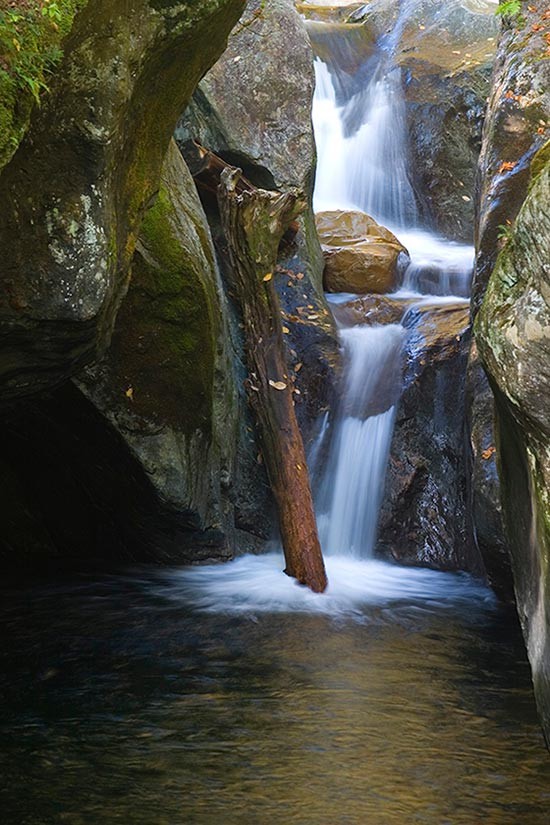My walking up here is a form of yoga practice, I suppose – call it the practice of being perfectly content. I’m descending today, down a steeply sloping ridge on the eastern-most edge of the Pemigewasset Wilderness. The trail follows a buckling and cool impression in the rocky soil. A while back there were frost particles, cracked and sun-softened and dropping down onto my neck.
But at this elevation, perhaps a thousand feet below, enough weather in various forms has accumulated so that I am descending alongside, or in the company of, a stream. Few know its source because, technically, there isn’t one. The boundary condition between weather and waterfall is a subtle and chaotic thing to trace. The stream begins as a humid wind, a rainfall, or a softened plate of snow, and it ends, or dissolves, into a lake with a Native American name or the North Atlantic, passing from the rock channel to an outer nowhere, just as we all do.
The stream in these woods makes excellent company.
The rainfall-river interface is vague. The rocks maybe darken, the lichen and algae maybe become just a bit more luscious, and then there is a collection of minor tricklings, a merging of the weather and the dew. At some point you have something called a stream, where a foot uphill there wasn’t one. On the sturdy and waterproof maps of the Appalachian Mountain Club, the water courses appear as thin blue lines. Up above a certain altitude the lines become thinner and then dotty, as if to symbolize the shifting nature of their source in clouds which themselves cannot even be represented. How vague they are: you’d need a new map every morning, and then another edition at lunch. But anyway, the clouds spill, and they certainly spilled last night, and the stream here is mappable and loud. A billion variations of bubbling and foam cascade, and all along the banks the vegetation is dripping and donating more water to the cause. A mile below the summit this channel runs all year. And it has run, according to the flume’s basin structure, maybe millions of years.
First there is a loud and white waterfall, lashing its way down through a boulder trough and granite ledges. In places it is difficult to see, shielded by the overarching canopy of birch and pine trees, and the luscious fern channel on either side. I get glimpses of the splashing, and when the trail is close enough, I can taste the spray on the wind.
Georg Christoph Lichtenberg said of the mind: “We should say it thinks, just as we say it thunders.” Or, as we say: the stream runs. But just exactly here, for some reason, in this secret and I would like to say sacred spot, the waterfall, in the course of its aeons of more or less steady falling, has gouged a small, round basin in the rock. The action of the weather-water has also polished and arranged a floor of stones. And then by some preposterous beauty, the water drilled a channel for itself in 50 feet of solid granite, creating what is called a flume. The water in the basin is about chest-deep, but to reach it you have to wade upstream, through the water’s own carving.
It is an ordinary day in late summer, in the region of Pemigewasset. My legs are tired from a week of climbing, and I have read that athletes use ice baths now to help their muscles recover, but that has nothing to do with what happens next. A strange Pemigewasset sort of fit comes over me. In less than a minute my pack is down. My nasty BO clothes are on the ground. Barefoot, first on the sponge moss and then on the icicle rocks, I am wading up into the rock vulva. It’s so cold that my feet can’t feel how sharp the rocks are, so that’s a help. Then I’m chest-deep in the basin, and all below the neck line has frozen shut. And then – final penetration into the earth mystery – I’m in the waterfall itself. Gasping in the loud weather; entering the stream.
Knowing your country in this way is a direct transmission: it is more than we are. Like the stream, the land is what we are from and where we are going. I sort of “know” this in a quick illumination; and then, of course, even the knowing mind goes numb.
Wading back out through the flume channel, my eyes have opened. The coloring of the stones is so beautiful. Grey ones, chalky white ice-colored stones, some that are the color of barley, some black as night. There is no sound at all but the waterfall, but wait, no: it is waterfall blended with wind, and the wind itself is blended with the fragrance of the pine. It is total contentment. Maybe the practice works.
For thousands of years, in hundreds of cultures, water has been held in highest esteem.
I am completely and totally and originally alone. This is why I have come up here, to the White Mountains, and even setting out to come here I wouldn’t have known. Maybe I have been drawn, or pulled.
The stream’s movement is also called being moved. It is very emotional, in a calm way. Either that or I am psychotic, which is certainly possible. In the words of a Cree shaman:
“When the water hits the rock, it goes up in steam, fills the air and unifies everything.
At that moment we are connecting ourselves to the basic elements of life, and that brings out
the greatest good.
We are connecting to the movement that is all around us, that we are part of,
and cannot be separate from.”
Dry my shivering cadaver with my wool cap. Ten minutes of walking and I am more or less myself. Except I feel very clean and very strange and very happy.


